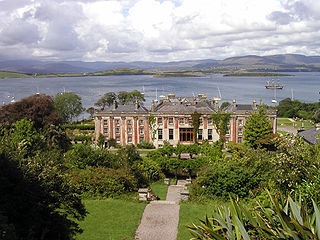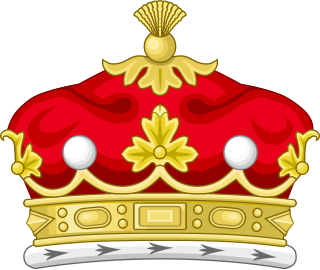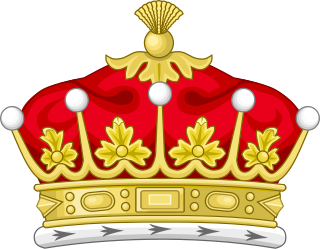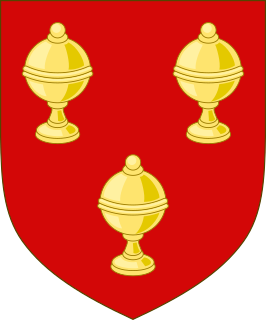 W
WEarl of Bantry, of Bantry in the County of Cork, was a title in the Peerage of Ireland. It was created in 1816 for Richard White, 1st Viscount Bantry, who had helped repelling the French invasion at Bantry Bay in 1797. He had already been created Baron Bantry, of Bantry in the County of Cork, and Viscount Bantry, of Bantry in the County of Cork, in 1800, and was made Viscount Berehaven at the same time he was given the earldom. These titles were also in the Peerage of Ireland. He was the grandson of Richard White, who had made an immense fortune through his work as a lawyer. Lord Bantry was succeeded by his son, the second Earl. He sat on the Conservative benches in the House of Lords as an Irish Representative Peer from 1854 to 1868. His younger brother, the third Earl, assumed in 1840 by Royal licence the additional surname of Hedges, which was that of his paternal grandmother. He was an Irish Representative Peer from 1869 to 1884. The titles became extinct on the death of his son, the fourth Earl, in 1891.
 W
WEarl of Bantry, of Bantry in the County of Cork, was a title in the Peerage of Ireland. It was created in 1816 for Richard White, 1st Viscount Bantry, who had helped repelling the French invasion at Bantry Bay in 1797. He had already been created Baron Bantry, of Bantry in the County of Cork, and Viscount Bantry, of Bantry in the County of Cork, in 1800, and was made Viscount Berehaven at the same time he was given the earldom. These titles were also in the Peerage of Ireland. He was the grandson of Richard White, who had made an immense fortune through his work as a lawyer. Lord Bantry was succeeded by his son, the second Earl. He sat on the Conservative benches in the House of Lords as an Irish Representative Peer from 1854 to 1868. His younger brother, the third Earl, assumed in 1840 by Royal licence the additional surname of Hedges, which was that of his paternal grandmother. He was an Irish Representative Peer from 1869 to 1884. The titles became extinct on the death of his son, the fourth Earl, in 1891.
 W
WMarquess Conyngham, of the County of Donegal, is a title in the Peerage of Ireland. It was created in 1816 for Henry Conyngham, 1st Earl Conyngham. He was the great-nephew of another Henry Conyngham, 1st Earl Conyngham, a member of a family of Scottish descent which had settled during the Plantation of Ulster in County Donegal in Ireland in the early 17th century. The 'founder' of the dynasty in Ireland was The Very Rev. Dr. Alexander Cunningham, Dean of Raphoe. The earlier Henry was a member of both the Irish House of Commons and the British House of Commons and served as Vice-Admiral of Ulster and as Governor of the counties of Donegal and Londonderry. In 1753 he was raised to the Peerage of Ireland as Baron Conyngham, of Mount Charles in the County of Donegal, and in 1756 he was created Viscount Conyngham, in Ireland, also in the Peerage of Ireland. In 1781 he was made Baron Conyngham, of Mount Charles in the County of Donegal, with remainder to his nephew Francis Burton, and Earl Conyngham, of Mount Charles in the County of Donegal, which like the creations of 1753 and 1756 was created with normal remainder to the heirs male of his body. The latter titles were also in the Peerage of Ireland. Lord Conyngham was childless and on his death in 1781 the barony of 1753, the viscountcy and earldom became extinct while he was succeeded in the barony of 1781 according to the special remainder by his aforementioned nephew Francis. He was the eldest son of Mary, sister of the first Earl Conyngham, by her husband Francis Burton. The new 2nd Baron Conyngham, who had earlier represented Killybegs and County Clare in the Irish House of Commons, assumed by Royal licence the surname and arms of Conyngham on succeeding to the titles.
 W
WEarl de Grey, of Wrest in the County of Bedford, was a title in the Peerage of the United Kingdom.
 W
WEarl of Listowel is a title in the Peerage of Ireland. It was created in 1822 for William Hare, 1st Viscount Ennismore and Listowel, who had earlier represented Cork City and Athy in the Irish House of Commons.
 W
WViscount Exmouth, of Canonteign in the County of Devon, is a title in the Peerage of the United Kingdom.
 W
WViscount Frankfort de Montmorency, of Galmoye in the County of Kilkenny, was a title in the Peerage of Ireland. It was created on 22 January 1816 for Lodge de Montmorency, 1st Baron Frankfort, who had earlier represented Bandon Bridge, Dingle, Inistioge and Ennis in the Irish House of Commons. He had already been made Baron Frankfort, of Galmoye in the County of Kilkenny, on 31 July 1800, also in the Peerage of Ireland. Born Lodge Evans Morres, he assumed in 1815 by Royal licence the surname of de Montmorency in lieu of Morres. However, the French House of de Montmorency never recognised his claim to be a member of that house. His grandson, the third Viscount, was a Major-General in the British Army and sat in the House of Lords as an Irish Representative Peer between 1900 and 1902. The latter's eldest son, the Honourable Raymond de Montmorency, was awarded the Victoria Cross for his actions at the Battle of Omdurman in 1898. He was killed in action in the Second Boer War two years later, predeceasing his father by two years. The third Viscount was succeeded by his second and only surviving son, the fourth Viscount. He was also a soldier. He died childless in 1917 when the titles became extinct.
 W
WBaron Cottesloe, of Swanbourne and Hardwick in the County of Buckingham, is a title in the Peerage of the United Kingdom. It was created on 2 March 1874 for the Conservative politician and former Chief Secretary for Ireland, Sir Thomas Fremantle, 1st Baronet (1798–1890). He was the son of Admiral Sir Thomas Fremantle (1765–1819). Lord Cottesloe had already been created a Baronet, of Swanbourne in the County of Buckingham, on 14 August 1821, chiefly in recognition of his father's services, and with remainder to the latter's heirs. His father Sir Thomas Fremantle was created Baron Fremantle, of the Austrian Empire, which Lord Cottesloe inherited in 1819 with the death of his father. Subsequently, in 1822 he was given a Royal licence, which authorized him and his successors to use the title in Britain. However, a warrant issued on 27 April 1932 withdrew all the royal licences, only allowing the use of the title to the then current holders, their heir and their heir's heir. The fifth baron was the last holder being allowed to use the Austrian title in the United Kingdom.
 W
WMarquess of Hastings was a title in the Peerage of the United Kingdom. It was created on 6 December 1816 for Francis Rawdon-Hastings, 2nd Earl of Moira.
 W
WViscount Hill, of Hawkstone and of Hardwicke in the County of Salop, is a title in the Peerage of the United Kingdom. It was created in 1842 for General Rowland Hill. He had already been created Baron Hill, of Almaraz and of Hawkstone in the County of Salop, in 1814, with remainder to the heirs male of his body, and Baron Hill, of Almarez and of Hawkestone and Hardwicke in the County of Salop, in 1816, with remainder to the heirs male of his elder brother John Hill. The viscountcy was created with the same special remainder. On the first Viscount's death in 1842, the barony of 1814 became extinct as he had no male issue, while he was succeeded in the barony of 1816 and the Viscountcy according to the special remainders by his nephew Sir Rowland Hill, 4th Baronet. His son, the 3rd Viscount, sat as a Conservative Member of Parliament for Shropshire North. In 1875, he assumed by Royal licence the additional surname of Clegg, which was that of his maternal grandfather. He inherited financial problems from his father which led to the breakup and sale of the family estates.
 W
WMarquess of Londonderry, of the County of Londonderry, is a title in the Peerage of Ireland.
 W
WMarquess of Hastings was a title in the Peerage of the United Kingdom. It was created on 6 December 1816 for Francis Rawdon-Hastings, 2nd Earl of Moira.
 W
WMarquess Conyngham, of the County of Donegal, is a title in the Peerage of Ireland. It was created in 1816 for Henry Conyngham, 1st Earl Conyngham. He was the great-nephew of another Henry Conyngham, 1st Earl Conyngham, a member of a family of Scottish descent which had settled during the Plantation of Ulster in County Donegal in Ireland in the early 17th century. The 'founder' of the dynasty in Ireland was The Very Rev. Dr. Alexander Cunningham, Dean of Raphoe. The earlier Henry was a member of both the Irish House of Commons and the British House of Commons and served as Vice-Admiral of Ulster and as Governor of the counties of Donegal and Londonderry. In 1753 he was raised to the Peerage of Ireland as Baron Conyngham, of Mount Charles in the County of Donegal, and in 1756 he was created Viscount Conyngham, in Ireland, also in the Peerage of Ireland. In 1781 he was made Baron Conyngham, of Mount Charles in the County of Donegal, with remainder to his nephew Francis Burton, and Earl Conyngham, of Mount Charles in the County of Donegal, which like the creations of 1753 and 1756 was created with normal remainder to the heirs male of his body. The latter titles were also in the Peerage of Ireland. Lord Conyngham was childless and on his death in 1781 the barony of 1753, the viscountcy and earldom became extinct while he was succeeded in the barony of 1781 according to the special remainder by his aforementioned nephew Francis. He was the eldest son of Mary, sister of the first Earl Conyngham, by her husband Francis Burton. The new 2nd Baron Conyngham, who had earlier represented Killybegs and County Clare in the Irish House of Commons, assumed by Royal licence the surname and arms of Conyngham on succeeding to the titles.
 W
WEarl of Dunraven and Mount-Earl was a title in the Peerage of Ireland. It was created on 5 February 1822 for Valentine Quin, 1st Viscount Mount-Earl. Quin had already been created a Baronet, of Adare in County Limerick, in the Baronetage of Ireland, in 1781, Baron Adare, of Adare in the County of Limerick, on 31 July 1800, and Viscount Mount-Earl on 3 February 1816. He was made Viscount Adare in 1822 at the same time as he was given the earldom. The latter peerage titles were also in the Peerage of Ireland. The Quins were unusual among Irish landowning families in that era in being of Gaelic origin, although they married into Anglo-Irish families like the Widenhams of Kildimo and the Dawsons of Dublin.
 W
WThe peerage title Earl of Ormond and the related titles Duke of Ormonde and Marquess of Ormonde have a long and complex history. An earldom of Ormond has been created three times in the Peerage of Ireland.
 W
WBaron Sheffield is a title that has been created four times: once in the Peerage of England, twice in the Peerage of Ireland, and once in the Peerage of the United Kingdom.
 W
WAdmiral Algernon Percy, 4th Duke of Northumberland,, styled Lord Algernon Percy from birth until 1816 and known as Lord Prudhoe between 1816 and 1847, was a British naval commander, explorer and Conservative politician.
 W
WMarquess of Hastings was a title in the Peerage of the United Kingdom. It was created on 6 December 1816 for Francis Rawdon-Hastings, 2nd Earl of Moira.
 W
WBaron Sheffield is a title that has been created four times: once in the Peerage of England, twice in the Peerage of Ireland, and once in the Peerage of the United Kingdom.